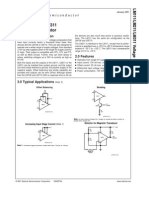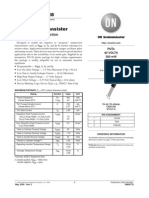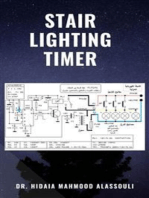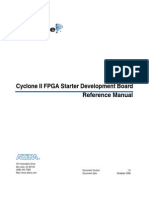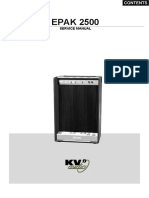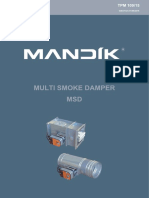Sensor de Temperatura LM50
Sensor de Temperatura LM50
Uploaded by
Erick Dos SantosCopyright:
Available Formats
Sensor de Temperatura LM50
Sensor de Temperatura LM50
Uploaded by
Erick Dos SantosCopyright
Available Formats
Share this document
Did you find this document useful?
Is this content inappropriate?
Copyright:
Available Formats
Sensor de Temperatura LM50
Sensor de Temperatura LM50
Uploaded by
Erick Dos SantosCopyright:
Available Formats
LM50 SOT-23 Single-Supply Centigrade Temperature Sensor
July 1999
LM50 SOT-23 Single-Supply Centigrade Temperature Sensor
General Description
The LM50 is a precision integrated-circuit temperature sensor that can sense a 40C to +125C temperature range using a single positive supply. The LM50s output voltage is linearly proportional to Celsius (Centigrade) temperature (+10 mV/C) and has a DC offset of +500 mV. The offset allows reading negative temperatures without the need for a negative supply. The ideal output voltage of the LM50 ranges from +100 mV to +1.75V for a 40C to +125C temperature range. The LM50 does not require any external calibration or trimming to provide accuracies of 3C at room temperature and 4C over the full 40C to +125C temperature range. Trimming and calibration of the LM50 at the wafer level assure low cost and high accuracy. The LM50s linear output, +500 mV offset, and factory calibration simplify circuitry required in a single supply environment where reading negative temperatures is required. Because the LM50s quiescent current is less than 130 A, self-heating is limited to a very low 0.2C in still air.
Applications
n n n n n n n n n Computers Disk Drives Battery Management Automotive FAX Machines Printers Portable Medical Instruments HVAC Power Supply Modules
Features
n n n n n n n n n n Calibrated directly in degree Celsius (Centigrade) Linear + 10.0 mV/C scale factor 2C accuracy guaranteed at +25C Specified for full 40 to +125C range Suitable for remote applications Low cost due to wafer-level trimming Operates from 4.5V to 10V Less than 130 A current drain Low self-heating, less than 0.2C in still air Nonlinearity less than 0.8C over temp
Connection Diagram
SOT-23 Order Number LM50BIM3 LM50CIM3
DS012030-1
SOT-23 Device Marking T5B T5C T5B T5C
Supplied As 1000 Units on Tape and Reel 1000 Units on Tape and Reel 3000 Units on Tape and Reel 3000 Units on Tape and Reel
LM50BIM3X LM50CIM3X
Top View See NS Package Number MA03B
Typical Application
DS012030-3
FIGURE 1. Full-Range Centigrade Temperature Sensor (40C to +125C)
1999 National Semiconductor Corporation
DS012030
www.national.com
Absolute Maximum Ratings (Note 1)
Supply Voltage Output Voltage Output Current Storage Temperature Lead Temperature: SOT Package (Note 2): Vapor Phase (60 seconds) Infrared (15 seconds) TJMAX, Maximum Junction Temperature +12V to 0.2V (+VS + 0.6V) to 1.0V 10 mA 65C to +150C
ESD Susceptibility (Note 3): Human Body Model Machine Model
2000V 250V
Operating Ratings (Note 1)
Specified Temperature Range: LM50C LM50B Operating Temperature Range JA (Note 4) Supply Voltage Range (+VS) TMIN to TMAX 40C to +125C 25C to +100C 40C to +150C 450C/W +4.5V to +10V
215C 220C 150C
Electrical Characteristics
Unless otherwise noted, these specifications apply for VS = +5 VDC and ILOAD = +0.5 A, in the circuit of Figure 1. Boldface limits apply for the specified TA = TJ = TMIN to TMAX; all other limits TA = TJ = +25C, unless otherwise noted. Parameter Conditions Typical Accuracy (Note 6) Nonlinearity (Note 7) Sensor Gain (Average Slope) Output Resistance Line Regulation (Note 8) Quiescent Current (Note 9) Change of Quiescent Current (Note 9) Temperature Coefficient of Quiescent Current Long Term Stability (Note 10) TJ = 125C, for 1000 hours
Note 1: Absolute Maximum Ratings indicate limits beyond which damage to the device may occur. DC and AC electrical specifications do not apply when operating the device beyond its rated operating conditions. Note 2: See AN-450 Surface Mounting Methods and Their Effect on Product Reliability or the section titled Surface Mount found in a current National Semiconductor Linear Data Book for other methods of soldering surface mount devices. Note 3: Human body model, 100 pF discharged through a 1.5 k resistor. Machine model, 200 pF discharged directly into each pin. Note 4: Thermal resistance of the SOT-23 package is specified without a heat sink, junction to ambient. Note 5: Limits are guaranteed to Nationals AOQL (Average Outgoing Quality Level). Note 6: Accuracy is defined as the error between the output voltage and 10mv/C times the devices case temperature plus 500 mV, at specified conditions of voltage, current, and temperature (expressed in C). Note 7: Nonlinearity is defined as the deviation of the output-voltage-versus-temperature curve from the best-fit straight line, over the devices rated temperature range. Note 8: Regulation is measured at constant junction temperature, using pulse testing with a low duty cycle. Changes in output due to heating effects can be computed by multiplying the internal dissipation by the thermal resistance. Note 9: Quiescent current is defined in the circuit of Figure 1 . Note 10: For best long-term stability, any precision circuit will give best results if the unit is aged at a warm temperature, and/or temperature cycled for at least 46 hours before long-term life test begins. This is especially true when a small (Surface-Mount) part is wave-soldered; allow time for stress relaxation to occur. The majority of the drift will occur in the first 1000 hours at elevated temperatures. The drift after 1000 hours will not continue at the first 1000 hour rate.
LM50B Limit (Note 5)
LM50C Typical Limit (Note 5)
Units (Limit)
TA = +25C TA = TMAX TA = TMIN
2.0 3.0
+3.0, 3.5
0.8
+9.7 +10.3 2000 +4.5V VS +10V +4.5V VS +10V +4.5V VS +10V +1.0 4000 2000
3.0 4.0 4.0 0.8
+9.7 +10.3 4000
C (max) C (max) C (max) C (max) mV/C (min) mV/C (max) (max) mV/V (max) mV/V (max) A (max) A (max) A (max) A/C C
0.8 1.2
130 180 2.0 +2.0
0.8 1.2
130 180 2.0
0.08
0.08
www.national.com
Typical Performance Characteristics
circuit board as shown in Figure 2. Thermal Resistance Junction to Air
To generate these curves the LM50 was mounted to a printed
Thermal Time Constant
Thermal Response in Still Air with Heat Sink (Figure 2)
DS012030-22 DS012030-21 DS012030-23
Thermal Response in Stirred Oil Bath with Heat Sink
Start-Up Voltage vs Temperature
Thermal Response in Still Air without a Heat Sink
DS012030-25 DS012030-24
DS012030-26
Quiescent Current vs Temperature (Figure 1)
Accuracy vs Temperature
Noise Voltage
DS012030-28 DS012030-27
DS012030-29
www.national.com
Typical Performance Characteristics
circuit board as shown in Figure 2. (Continued) Supply Voltage vs Supply Current
To generate these curves the LM50 was mounted to a printed
Start-Up Response
DS012030-31
DS012030-30
as Humiseal and epoxy paints or dips are often used to ensure that moisture cannot corrode the LM50 or its connections. Temperature Rise of LM50 Due to Self-Heating (Thermal Resistance, JA) SOT-23 no heat sink* Still air Moving air 450C/W SOT-23 small heat fin** 260C/W 180C/W
* Part soldered to 30 gauge wire. ** Heat sink used is 12" square printed circuit board with 2 oz. foil with part at-
tached as shown in Figure 2.
DS012030-19
FIGURE 2. Printed Circuit Board Used for Heat Sink to Generate All Curves. 12" Square Printed Circuit Board with 2 oz. Foil or Similar
2.0 Capacitive Loads
1.0 Mounting
The LM50 can be applied easily in the same way as other integrated-circuit temperature sensors. It can be glued or cemented to a surface and its temperature will be within about 0.2C of the surface temperature. This presumes that the ambient air temperature is almost the same as the surface temperature; if the air temperature were much higher or lower than the surface temperature, the actual temperature of the LM50 die would be at an intermediate temperature between the surface temperature and the air temperature. To ensure good thermal conductivity the backside of the LM50 die is directly attached to the GND pin. The lands and traces to the LM50 will, of course, be part of the printed circuit board, which is the object whose temperature is being measured. These printed circuit board lands and traces will not cause the LM50s temperature to deviate from the desired temperature. Alternatively, the LM50 can be mounted inside a sealed-end metal tube, and can then be dipped into a bath or screwed into a threaded hole in a tank. As with any IC, the LM50 and accompanying wiring and circuits must be kept insulated and dry, to avoid leakage and corrosion. This is especially true if the circuit may operate at cold temperatures where condensation can occur. Printed-circuit coatings and varnishes such
www.national.com 4
DS012030-7
FIGURE 3. LM50 No Decoupling Required for Capacitive Load
DS012030-8
FIGURE 4. LM50C with Filter for Noisy Environment The LM50 handles capacitive loading very well. Without any special precautions, the LM50 can drive any capacitive load. The LM50 has a nominal 2 k output impedance (as can be seen in the block diagram). The temperature coefficient of the output resistors is around 1300 ppm/C. Taking into account this temperature coefficient and the initial tolerance of the resistors the output impedance of the LM50 will not exceed 4 k. In an extremely noisy environment it may be necessary to add some filtering to minimize noise pickup. It is recommended that 0.1 F be added from VIN to GND to by-
2.0 Capacitive Loads
(Continued)
pass the power supply voltage, as shown in Figure 4. In a noisy environment it may be necessary to add a capacitor from the output to ground. A 1 F output capacitor with the 4 k output impedance will form a 40 Hz lowpass filter. Since
the thermal time constant of the LM50 is much slower than the 25 ms time constant formed by the RC, the overall response time of the LM50 will not be significantly affected. For much larger capacitors this additional time lag will increase the overall response time of the LM50.
DS012030-17
*R2 2k with a typical 1300 ppm/C drift.
FIGURE 5. Block Diagram
3.0 Typical Applications
DS012030-11
FIGURE 6. Centigrade Thermostat/Fan Controller
DS012030-13
FIGURE 7. Temperature To Digital Converter (Serial Output) (+125C Full Scale)
www.national.com
3.0 Typical Applications
(Continued)
DS012030-14
FIGURE 8. Temperature To Digital Converter (Parallel TRI-STATE Outputs for Standard Data Bus to P Interface) (125C Full Scale)
DS012030-16
FIGURE 9. LM50 With Voltage-To-Frequency Converter And Isolated Output (40C to +125C; 100 Hz to 1750 Hz)
www.national.com
LM50 SOT-23 Single-Supply Centigrade Temperature Sensor
Physical Dimensions
inches (millimeters) unless otherwise noted
SOT-23 Molded Small Outline Transistor Package (M3) Order Number LM50BIM3, or LM50CIM3 NS Package Number MA03B
LIFE SUPPORT POLICY NATIONALS PRODUCTS ARE NOT AUTHORIZED FOR USE AS CRITICAL COMPONENTS IN LIFE SUPPORT DEVICES OR SYSTEMS WITHOUT THE EXPRESS WRITTEN APPROVAL OF THE PRESIDENT AND GENERAL COUNSEL OF NATIONAL SEMICONDUCTOR CORPORATION. As used herein: 1. Life support devices or systems are devices or systems which, (a) are intended for surgical implant into the body, or (b) support or sustain life, and whose failure to perform when properly used in accordance with instructions for use provided in the labeling, can be reasonably expected to result in a significant injury to the user.
National Semiconductor Corporation Americas Tel: 1-800-272-9959 Fax: 1-800-737-7018 Email: support@nsc.com www.national.com National Semiconductor Europe Fax: +49 (0) 1 80-530 85 86 Email: europe.support@nsc.com Deutsch Tel: +49 (0) 1 80-530 85 85 English Tel: +49 (0) 1 80-532 78 32 Franais Tel: +49 (0) 1 80-532 93 58 Italiano Tel: +49 (0) 1 80-534 16 80
2. A critical component is any component of a life support device or system whose failure to perform can be reasonably expected to cause the failure of the life support device or system, or to affect its safety or effectiveness.
National Semiconductor Asia Pacific Customer Response Group Tel: 65-2544466 Fax: 65-2504466 Email: sea.support@nsc.com
National Semiconductor Japan Ltd. Tel: 81-3-5639-7560 Fax: 81-3-5639-7507
National does not assume any responsibility for use of any circuitry described, no circuit patent licenses are implied and National reserves the right at any time without notice to change said circuitry and specifications.
This datasheet has been download from: www.datasheetcatalog.com Datasheets for electronics components.
You might also like
- Datasheet For LM45Document9 pagesDatasheet For LM45Bhimsen BudhathokiNo ratings yet
- LM61 SensorDocument9 pagesLM61 SensorTalles VianaNo ratings yet
- LM45B/LM45C SOT-23 Precision Centigrade Temperature Sensors: General DescriptionDocument9 pagesLM45B/LM45C SOT-23 Precision Centigrade Temperature Sensors: General DescriptionTuấn ThiệnNo ratings yet
- Features Description: LT3085 Adjustable 500ma Single Resistor Low Dropout RegulatorDocument28 pagesFeatures Description: LT3085 Adjustable 500ma Single Resistor Low Dropout Regulatoram1liNo ratings yet
- Datasheet PDFDocument13 pagesDatasheet PDFclaudiu72No ratings yet
- Termistor LM35Document13 pagesTermistor LM35Betty SánchezNo ratings yet
- Datasheet Lm35anDocument21 pagesDatasheet Lm35anDaniiel GuerreroNo ratings yet
- LM35 Precision Centigrade Temperature Sensors: Features DescriptionDocument25 pagesLM35 Precision Centigrade Temperature Sensors: Features DescriptionMary RamiireezNo ratings yet
- 7805 Regulator DatasheetDocument11 pages7805 Regulator DatasheetPrabeesh P PrasanthiNo ratings yet
- LM35Document15 pagesLM35filipecampospereiraNo ratings yet
- LM 317 MPDocument25 pagesLM 317 MPsuhaila38No ratings yet
- LM334Document26 pagesLM3342567daNo ratings yet
- LM 393Document8 pagesLM 393vqylayNo ratings yet
- L75B (LM2937) Low Dropout RegulatorDocument11 pagesL75B (LM2937) Low Dropout Regulatorel_george0079491No ratings yet
- LM341, LM78M05, LM78M12, LM78M15: LM341/LM78MXX Series 3-Terminal Positive Voltage RegulatorsDocument13 pagesLM341, LM78M05, LM78M12, LM78M15: LM341/LM78MXX Series 3-Terminal Positive Voltage RegulatorskevharveyNo ratings yet
- LM350 3.0 A, Adjustable Output, Positive Voltage RegulatorDocument10 pagesLM350 3.0 A, Adjustable Output, Positive Voltage RegulatorAlvaro Martin RamaNo ratings yet
- Advanced Monolithic Systems: Features ApplicationsDocument8 pagesAdvanced Monolithic Systems: Features ApplicationsAndres AlegriaNo ratings yet
- TMP 35 GDocument16 pagesTMP 35 GWeslley FariaNo ratings yet
- 0 KGQ 8 Raur 90 ZD 8 X 13 TyhlehluefyDocument13 pages0 KGQ 8 Raur 90 ZD 8 X 13 TyhlehluefyRaja ReddyNo ratings yet
- LM35 Precision Centigrade Temperature Sensors: General DescriptionDocument13 pagesLM35 Precision Centigrade Temperature Sensors: General Descriptionpartidopartido7890No ratings yet
- LM35Document13 pagesLM35charls3400No ratings yet
- D D D D D D D: MOC3009 THRU MOC3012 Optocouplers/OptoisolatorsDocument7 pagesD D D D D D D: MOC3009 THRU MOC3012 Optocouplers/OptoisolatorsFer TgNo ratings yet
- Reg - LM2931Document18 pagesReg - LM2931Ludwig SchmidtNo ratings yet
- LM2937-3 3Document11 pagesLM2937-3 3SenaRahmadityaNo ratings yet
- lm35 PDFDocument15 pageslm35 PDFRogers Ferreras BenitezNo ratings yet
- Emp2 Box Pressure TransmitterDocument8 pagesEmp2 Box Pressure TransmitterAsif HameedNo ratings yet
- LM1084Document13 pagesLM1084message4guruNo ratings yet
- LM350Document9 pagesLM350Miguel VilcaNo ratings yet
- LM 334Document14 pagesLM 334Mai Van SyNo ratings yet
- Dat LM3940Document9 pagesDat LM3940Fredy PantiNo ratings yet
- LM311Document23 pagesLM311Brzata PticaNo ratings yet
- 2N6027Document9 pages2N6027mariogizziNo ratings yet
- 317mbg PDFDocument13 pages317mbg PDFrazali1982No ratings yet
- lm393 NDocument24 pageslm393 NL oNo ratings yet
- TOKO IC ProductsDocument429 pagesTOKO IC ProductsferenzosquintNo ratings yet
- LM350 DatasheetDocument12 pagesLM350 DatasheetOmarVelasquezC.No ratings yet
- Ame 1085Document17 pagesAme 1085Eduardo GarcíaNo ratings yet
- LM 337KDocument15 pagesLM 337Kmaster55No ratings yet
- Advanced Monolithic Systems: Rohs CompliantDocument9 pagesAdvanced Monolithic Systems: Rohs CompliantRobertoJavierANo ratings yet
- Advanced Monolithic Systems: Rohs CompliantDocument8 pagesAdvanced Monolithic Systems: Rohs CompliantWilliam BlackNo ratings yet
- AD590Document0 pagesAD590Alvaro Mompi RuizNo ratings yet
- LM117/LM317A/LM317 3-Terminal Adjustable Regulator: General DescriptionDocument20 pagesLM117/LM317A/LM317 3-Terminal Adjustable Regulator: General Descriptionjacctito2No ratings yet
- LM338KDocument20 pagesLM338Kmaster55100% (1)
- Features: LTK001 Thermocouple Cold Junction Compensator and Matched AmplifierDocument8 pagesFeatures: LTK001 Thermocouple Cold Junction Compensator and Matched AmplifierMudassar RafiqNo ratings yet
- Datasheet lm337Document8 pagesDatasheet lm337eduardo1011No ratings yet
- LM317, DatasheetDocument12 pagesLM317, DatasheetBocah IlangNo ratings yet
- Linear Integrated Circuit: 1A Low Dropout Positive Voltage RegulatorDocument7 pagesLinear Integrated Circuit: 1A Low Dropout Positive Voltage RegulatorRogério Machiaveli SavellaNo ratings yet
- Reference Guide To Useful Electronic Circuits And Circuit Design Techniques - Part 1From EverandReference Guide To Useful Electronic Circuits And Circuit Design Techniques - Part 1Rating: 2.5 out of 5 stars2.5/5 (3)
- Influence of System Parameters Using Fuse Protection of Regenerative DC DrivesFrom EverandInfluence of System Parameters Using Fuse Protection of Regenerative DC DrivesNo ratings yet
- Reference Guide To Useful Electronic Circuits And Circuit Design Techniques - Part 2From EverandReference Guide To Useful Electronic Circuits And Circuit Design Techniques - Part 2No ratings yet
- Introduction to Power System ProtectionFrom EverandIntroduction to Power System ProtectionRating: 5 out of 5 stars5/5 (1)
- Design of Electrical Circuits using Engineering Software ToolsFrom EverandDesign of Electrical Circuits using Engineering Software ToolsNo ratings yet
- Amplificador Operacional Jfet-LF153, LF253, LF353Document10 pagesAmplificador Operacional Jfet-LF153, LF253, LF353Erick Dos SantosNo ratings yet
- Receptor AM CA3088Document5 pagesReceptor AM CA3088Erick Dos SantosNo ratings yet
- Cyclone II FPGA Starter Development Board Reference ManualDocument56 pagesCyclone II FPGA Starter Development Board Reference ManualErick Dos SantosNo ratings yet
- Motores de Passo NMB PDFDocument20 pagesMotores de Passo NMB PDFErick Dos SantosNo ratings yet
- MSC 1210 UgDocument280 pagesMSC 1210 UgErick Dos SantosNo ratings yet
- Data Sheets Ecc I On AdoraDocument23 pagesData Sheets Ecc I On AdoraAlanAvtoNo ratings yet
- Nte 876Document2 pagesNte 876julio quatriniNo ratings yet
- Harmonics White PaperDocument5 pagesHarmonics White PaperTan Kang YaoNo ratings yet
- Preventa XPS - XPSAF5130Document4 pagesPreventa XPS - XPSAF5130Nabil EnonuNo ratings yet
- BRZ1200.1D / BRZ1700.1D / BRZ2100.1D BRZ2400.1D / BRZ3000.1D ProDocument14 pagesBRZ1200.1D / BRZ1700.1D / BRZ2100.1D BRZ2400.1D / BRZ3000.1D ProArguetaManuelNo ratings yet
- Step Down Buck Converter XL4015 Module 5A - 32V ENDocument8 pagesStep Down Buck Converter XL4015 Module 5A - 32V ENwilsnicoNo ratings yet
- U1251 Operation ManualDocument6 pagesU1251 Operation ManualNayyar MahmoodNo ratings yet
- Table Arus MotorDocument2 pagesTable Arus Motorbendungan2No ratings yet
- DTV2760C 3Document17 pagesDTV2760C 3plasmapeteNo ratings yet
- External Alarm ImplementationDocument15 pagesExternal Alarm ImplementationFarid Abbasi100% (1)
- SEM203P Instruction ManualDocument2 pagesSEM203P Instruction ManualDaniel Adi SaputraNo ratings yet
- EE409 Final ExamDocument4 pagesEE409 Final ExamChido MusaNo ratings yet
- Face Master 1.7 Yedek ParçaDocument398 pagesFace Master 1.7 Yedek Parçaonur tezmanNo ratings yet
- Diagrama Scaune Incalzite 10k NTC PDFDocument4 pagesDiagrama Scaune Incalzite 10k NTC PDFliviuvistaNo ratings yet
- Spare Parts List: Arc 151i, Arc 201iDocument8 pagesSpare Parts List: Arc 151i, Arc 201iGurkan ÇetinkayaNo ratings yet
- Stepper Motor CatalogueDocument66 pagesStepper Motor Catalogueserlabtrieste100% (1)
- Breakers (Feeo Brand) : FEEO Surge Protection DeviceDocument26 pagesBreakers (Feeo Brand) : FEEO Surge Protection DeviceMech T RonicsNo ratings yet
- EPAK 2500: Service ManualDocument32 pagesEPAK 2500: Service ManualEdy PratamaNo ratings yet
- SCR Firing CircuitsDocument4 pagesSCR Firing CircuitsShubham Bagal100% (1)
- Transistors: "The Building Blocks of Electronics World"Document18 pagesTransistors: "The Building Blocks of Electronics World"Tariq AngelNo ratings yet
- DC Brushless Gear MotorDocument36 pagesDC Brushless Gear MotorPontes JuniorNo ratings yet
- 04 315 MVA 400 220 KV Varsana No QR R2 Jun 11Document89 pages04 315 MVA 400 220 KV Varsana No QR R2 Jun 11asodiyamechNo ratings yet
- Data Sheet 3VA9467-0HA20: ModelDocument5 pagesData Sheet 3VA9467-0HA20: ModelMohammedi Engineering SolutionsNo ratings yet
- Air Blast Circuit Breaker 1Document19 pagesAir Blast Circuit Breaker 1Bidya Bhusan MajiNo ratings yet
- Precion Lab 2Document4 pagesPrecion Lab 2Areeba MujtabaNo ratings yet
- Anexo 5 IDO-L.18.001-1212-EBD-5000-0 Electrical Design CriteriaDocument48 pagesAnexo 5 IDO-L.18.001-1212-EBD-5000-0 Electrical Design CriteriaRusNo ratings yet
- SSVT - A4 - 11-9-10S FinalDocument12 pagesSSVT - A4 - 11-9-10S FinalGuntur ArtantoNo ratings yet
- Volet-De-Desfumare-MSD Bun Cu Dimensiuni Mari Montaj Pe TubulaturaDocument40 pagesVolet-De-Desfumare-MSD Bun Cu Dimensiuni Mari Montaj Pe Tubulaturamarius_marchisNo ratings yet
- Easy 512 DC RDocument13 pagesEasy 512 DC RHaris MašićNo ratings yet
- Experiment No-1: Aim:-Low Resistance Using Kelvin Double BridgeDocument21 pagesExperiment No-1: Aim:-Low Resistance Using Kelvin Double BridgegnathblNo ratings yet






























